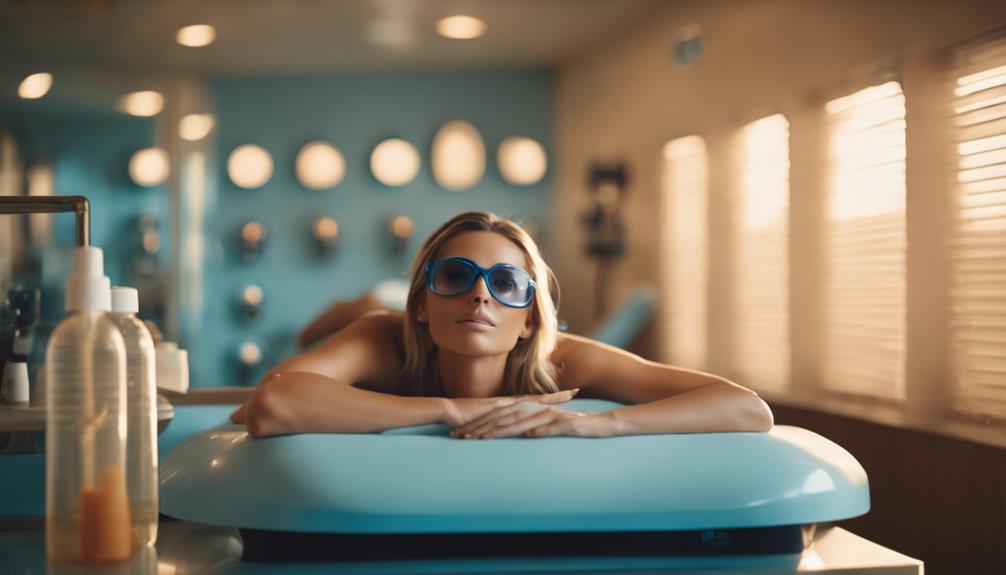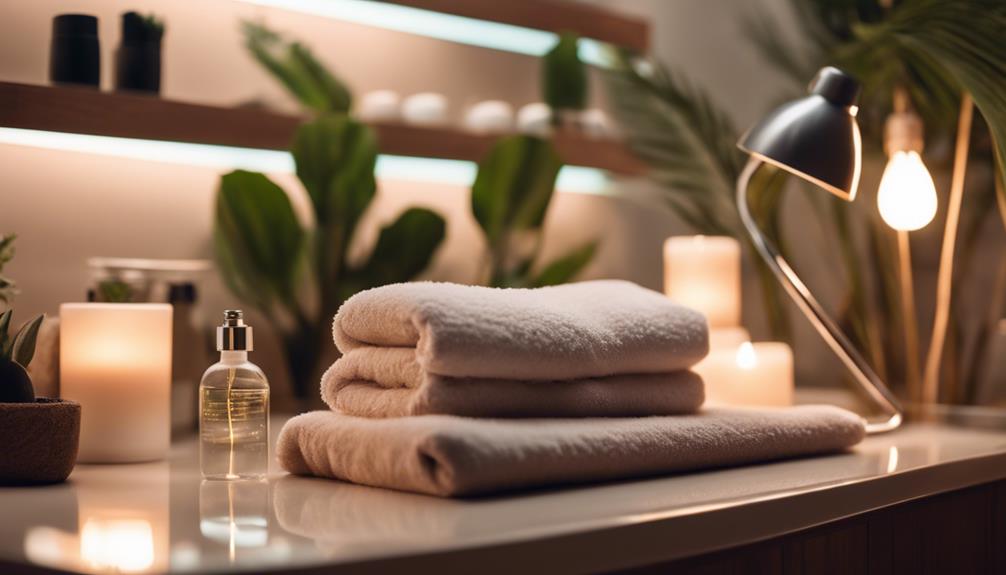Mastering safe techniques for tanning beds involves understanding your specific skin type and selecting the appropriate level of tanning bed. It is important to start with shorter session times and gradually increase them as your skin becomes accustomed to the exposure. For those with fair skin, it is recommended to limit initial sessions to 1-4 minutes based on skin sensitivity. Always remember to wear protective eyewear and consider using indoor tanning lotions for better results. Proper post-tanning care, which includes hydration and sun protection, is essential for maintaining a healthy glow. By following these tips, you can ensure a safer and more enjoyable tanning experience. There is much more to discover in order to optimize your tanning journey and improve skin health effectively.
Key Takeaways
- Identify your skin type to select the appropriate tanning bed level for optimal results and safety.
- Start with short tanning sessions, gradually increasing exposure time based on skin's response to minimize burn risk.
- Always wear protective eyewear and use indoor tanning lotions to enhance results and protect your skin.
- Limit tanning sessions to 2-3 times per week to allow for skin recovery and prevent irritation.
Understanding Skin Types
Understanding skin types is vital for determining safe tanning practices and optimizing results in tanning beds. Each skin type has unique characteristics that influence its response to UV exposure.
Type I individuals have very fair skin, burn easily, and possess minimal tanning potential, necessitating extreme caution.
Type II skin, though slightly more resilient, also burns easily and tans minimally.
In contrast, Type III skin has a medium tone, allowing for gradual tanning with some burn potential.
Type IV skin, characterized by an olive hue, tans easily with minimal risk of burning.
Recognizing your skin type is important for establishing effective tanning strategies, as it informs appropriate exposure durations and frequency, thereby enhancing safety and tanning outcomes.
Consulting tanning experts can further personalize your approach.
Tanning Bed Levels
Tanning beds are categorized into various levels, each designed to provide differing intensities of UV exposure to accommodate users' diverse tanning needs and skin types. Understanding these levels is crucial for selecting the appropriate tanning experience based on individual skin responses and desired results.
- Level 1: Gentle UV exposure, suitable for beginners and those with fair skin.
- Level 2 and 3: Moderate to strong UV intensity, ideal for users seeking deeper tans and with some tanning experience.
Choosing the right level guarantees a safer tanning process while optimizing results according to one's skin type and tanning goals.
Session Timing Guidelines

Establishing appropriate session timing is essential for maximizing tanning benefits while minimizing the risk of skin damage.
Different skin types dictate the initial duration of tanning sessions; for instance, individuals with Type I skin should start with just 1-3 minutes, while those with Type II can begin with 2-4 minutes.
Medium skin types, such as Type III, may initiate sessions lasting 4-8 minutes. It is vital to limit tanning to 2-3 times per week, allowing the skin sufficient time to recover between sessions.
Monitoring your skin's response during these sessions will help determine if longer exposure times are appropriate.
Employing these guidelines fosters a safer tanning experience and promotes healthy skin.
Gradual Time Increments
To promote a safe tanning experience, gradually increasing session times based on individual skin response is paramount. This approach minimizes the risk of burns while allowing the skin to acclimate to UV exposure.
Starting with shorter sessions enables users to gauge how their skin reacts to the tanning bed. Once initial sessions have been completed, users should monitor their skin closely before extending time increments.
- Begin with 1-3 minutes for fair skin types to prevent burns.
- Incrementally increase session times by 1-2 minutes as the skin develops a base tan.
This method fosters a healthier tanning experience while achieving desired results.
Safety Precautions

Guaranteeing safety during tanning bed sessions is vital for protecting skin health and minimizing the risk of adverse reactions.
First and foremost, always wear protective eyewear specifically designed to shield the eyes from harmful UV rays.
Additionally, utilizing tanning lotions formulated for indoor tanning can enhance results while nourishing the skin.
It is essential to refrain from tanning when exhibiting any signs of skin irritation or burns.
Consulting a dermatologist for a proper skin type assessment can provide valuable guidance tailored to individual needs.
Following salon guidelines regarding equipment usage and hygiene practices further guarantees a safe environment.
Post-Tanning Skin Care
Effective post-tanning skin care is essential for maintaining a healthy glow and prolonging the results of tanning sessions. Proper care not only enhances the appearance of your tan but also promotes skin health. Incorporating specific practices into your routine can greatly impact the longevity and vibrancy of your tan.
- Hydration: Use a high-quality moisturizer or tan extender to keep your skin hydrated and supple.
- Gentle Cleansing: Opt for mild, sulfate-free cleansers to avoid stripping the skin of moisture, preserving your tan.
Alternatives to Tanning Beds

Exploring alternatives to tanning beds provides a range of options for individuals seeking a sun-kissed glow without the risks associated with UV exposure.
Sunless tanning products, such as self-tanning lotions, allow users to gradually develop a tan over several days without harmful UV rays.
Spray tans offer an immediate, even color, ideal for special occasions, while bronzer makeup provides a temporary solution for instant radiance.
Additionally, natural oils and skincare products can enhance skin glow, promoting a healthy appearance.
These alternatives not only mitigate the risks of skin damage but also allow for customizable color intensity.
What are the safest tanning bed techniques to ensure a great tanning experience?
When looking for the best tanning bed experience unlock, it’s important to prioritize safety. Start with a low exposure time and gradually increase to avoid sunburn. Always wear protective eyewear and use the recommended lotions or oils for an even tan. Regularly clean the tanning bed to prevent bacteria buildup.
Conclusion
In the domain of sun-kissed aspirations, the tanning bed serves as a double-edged sword, offering warmth yet harboring potential peril.
Steering through this landscape requires wisdom akin to a seasoned sailor charting a course through treacherous waters.
By understanding skin types, adhering to session guidelines, and embracing safety measures, individuals can bask in the glow of their efforts without succumbing to the lurking dangers.
Consequently, the journey towards a radiant complexion becomes a harmonious dance between desire and diligence.










